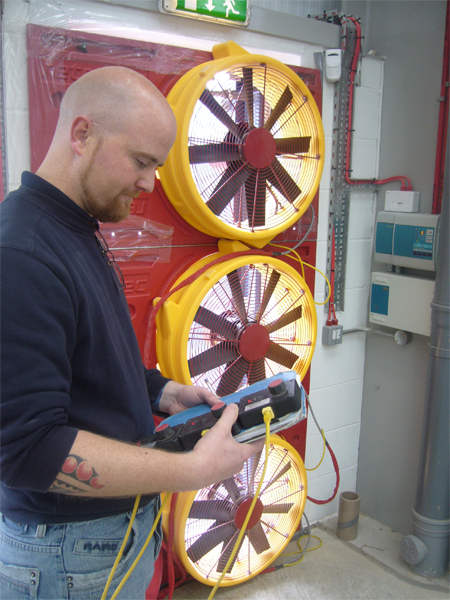Tom Gregory, head of Energy Services, Chiltern Dynamics ![]() , answers frequently asked questions about air tightness testing as required under Approved Document L.
, answers frequently asked questions about air tightness testing as required under Approved Document L.
Air testing has been a requirement of Approved Document L (ADL) for almost five years. The revision which took effect on 1 October 2010 has increased the complexity of test regimes and the number of tests needed. Demand for testing to the 2010 requirements is increasing for projects registered after 1 October 2010 and/or not started until October 2011.
Which projects need to be tested?
- New dwellings
- New buildings other than dwellings
- Extensions to buildings other than dwellings
What do buildings need to achieve?
With a 16% to 40% improvement in the Target Emission Rate (TER) under the 2010 revisions, it is unlikely that buildings will be able to achieve the overall targets for energy improvement without significantly improving air tightness. Although ADL refers to tested buildings achieving 10m³/(h.m²) at a pressure difference of 50Pa as a 'reasonable level' of air permeability, the actual requirement will often be significantly lower to achieve the overall TER.
Designers/builders will therefore need to weigh up whether to significantly improve air tightness performance, or to incur potentially more substantial costs by improving other factors that influence the SAP calculations, e.g. heating, renewable energy sources, etc. We would anticipate typical air testing targets improving from 6-10 down to 3-6.
In addition for dwellings, if air test results are to be re-used in SAP calculations for untested plots of the same dwelling type, a 'confidence' factor needs to be applied which means that the test results must be 2m³/(h.m²) at 50Pa better than the design air permeability allowed in the SAP calculation. In other words, if the target air permeability for the dwelling type in SAP is 6, the tested plot would need to achieve 4, for the result to be re-used in untested plots.
With or without the application of a confidence factor, air testing targets are likely to be significantly tighter in future. To assess what level of improvement is likely to be achievable and identify the most cost-effective method for meeting the improved requirements it is important that builders make the most of testing on current projects by ensuring their air testing body provides feedback on leakage paths and advice on potential improvements.
How many units need to be tested?
All 'non dwellings' must be tested. There are potential exceptions based on the floor area but these can only be applied where a poor air permeability of 15 is assumed in the emission calculations. This is unlikely to be practical or affordable due to the reduction in the overall energy efficiency of buildings, as it would mean vast improvements in areas such as heating, renewables, insulation, glazing, to balance out this relatively poor air tightness.

Airtight school doorway: all new buildings must be tested
Dwellings are subject to a sampling regime. Under the 2010 revision, 3 tests or 50% of each dwelling type must be tested.
The definition of types has changed and there are more types and therefore more tests on any development. In addition to variations in position (e.g. end terrace house or top floor flat), construction details and size (now defined as 10% difference in envelope area), other variables defining type include: design air permeability, number of significant penetrations (doors, windows, flues, soil vent pipes, etc), storey height and adjacency to unheated spaces (e.g. garages, stairwells).
Both these factors are likely to significantly increase the sample of plots needing testing on any development, based on proposals we have produced so far this may mean an increase from 10-25% of units to 40-70%.
Not forgetting that to test even these increased samples still requires the application of the confidence factor (i.e. test results of 2 better than the design air permeability in the SAP). The alternative is to test every plot on the site.
NB Exceptions for small housing developments are also less likely to be practical affordable for the reasons stated above for non-dwellings.
Who selects the sample to be tested?
Building Control will still have final say so but the expectation of the revised Regulations is for the air testing body to take a more leading role. The emphasis is still on testing early: half of the scheduled plots should be among the first 25% of completed types.
What sealing should take place in advance of testing?
Certain temporary sealing is allowed within the test standard (ATTMA TS L1 for dwellings and ATTMA TS L2 for non-dwellings), including mechanical and passive ventilation (i.e. trickle vents can now be taped but windows/doors still cannot).
Sometimes additional 'non-standard' temporary sealing is required which is typically listed on the test certificate. Often this is perfectly reasonable (e.g. broken pane of glass) but occasionally it can include kitchen units, openings and/or whole rooms which obviously does not reflect the end-use operation of the building.
Who is competent to conduct the test under ADL?
Building Control is authorised to accept evidence from a BINDT-registered tester.

Preparing for test: under Part L 2010 buildings will have to achieve significant improvement in air tightness
BINDT registration operates at 2 levels:
- BINDT L1 registration for an individual wishing to just test only dwellings can be achieved by attending an approved training course and using calibrated equipment
- BINDT L1 & L2 registration is only through company membership of the Air Tightness Testing and Measurement Association (ATTMA). This entails UKAS accreditation to vet procedures, equipment, procedures, training, on-site testing, etc, as well as technical review by ATTMA.
Building Control is responsible for checking that the tester has the appropriate training and is registered for the specific class of building.
What are the most common air leakage/ infiltration paths?
Achieving the required air permeability relies on identifying, creating and maintaining a continuous air barrier.
Historically, for buildings targeting 7-10 and using traditional construction methods, the air leakage paths have been relatively obvious and easy to address (i.e. mastic sealing and/or expanding foam). These include:
- Gaps between elements of the buildings, i.e. floor to wall and/or wall to roof, which create a small path, but potentially around the entire perimeter of the building. Most often in dwellings this is a gap between the underside of the plasterboard/skirting and the floor, while in non-dwellings it is a break in the continuity at the eaves detail (between the top of the wall and the underside of the roof)
- Gaps between different parts of the air barrier, e.g. the joint between membranes, boards, etc
- Gaps around 'penetrations', i.e. windows, doors, services, etc. This problem may often be masked by suspended ceilings, bath panels, kitchen units, voids and plasterboard where the dot and dab creates a small cavity that allows air to bypass any surface sealing and escape through larger openings through the structure
- Gaps around 'awkward' details, i.e. where the air barrier is interrupted by complicated structural members or elements of the fabric. These require attention at the design stage to identify ways of minimising these interruptions or introducing methods for bridging them to maintain continuity.
To achieve the likely air permeability requirements of the 2010 Revision to ADL, which is increasingly likely to be mean achieving less than 5, the above factors remain important but added vigilance will be required to address the more minor leakage paths which, in combination, could be the difference between passing and failing.
It is important to work with your air testing body to identify and quantify the likely air paths on any design, at an early a stage as is possible. Increasingly, architects are identifying the air barrier using a set of specific details or 'red lining' drawings. It is important that this air barrier is communicated to site who can make the responsible sub-contractors aware and monitor the relevant works at an appropriate stage in the construction.
For designs that are likely to be repeated (e.g. standard house types), builders have benefitted from reviewing the designs and carrying diagnoses on examples being currently built to identify potential improvements, as well as the air permeability performance limit for different designs. This will be critical to informing the right approach to air permeability targets to balance pragmatism and cost.
Further information
Chiltern Dynamics ![]() has produced a comparison table of the key changes to Part L for dwellings and non-dwellings, contrasting 2006 with 2010 requirements. To obtain a comparison table or for copies of Technical Information Sheets T1–1008 Air tightness testing and T1-0809 Achieving air tightness in buildings email cd@chilternfire.co.uk – all free of charge. For dates of free webinars visit www.chilternfire.co.uk/training
has produced a comparison table of the key changes to Part L for dwellings and non-dwellings, contrasting 2006 with 2010 requirements. To obtain a comparison table or for copies of Technical Information Sheets T1–1008 Air tightness testing and T1-0809 Achieving air tightness in buildings email cd@chilternfire.co.uk – all free of charge. For dates of free webinars visit www.chilternfire.co.uk/training ![]() .
.

